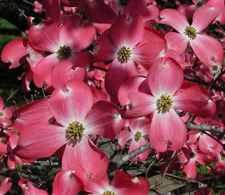Resource Library
Plant of the Week: Pink Dogwood
The University of Arkansas System Division of Agriculture does not promote, support or recommend plants featured in "Plant of the Week." Please consult your local Extension office for plants suitable for your region.
Plant of the Week
Pink Dogwood
Latin: Cornus florida 'Rubra'

The sight of a dogwood in bloom makes a nature lover out of even the most hardhearted curmudgeon. In a native flora liberally sprinkled with springtime flowering trees, the dogwood stands out as our most beloved symbol of spring. Though white is its main color, pink forms also occur.
Dogwoods (Cornus florida) are smallish, round-headed deciduous trees usually around 25 feet tall with a similar spread. They belong to the dogwood family and are represented by species in Europe, Asia and the western parts of North America, but Cornus florida is the undisputed champion of the genus.
It ranges throughout the eastern woodlands from the milder parts of New England and southward to northern Florida and into northern Mexico. The species' scientific name doesn't refer to the state of Florida but instead refers to the free-flowering nature of the species.
Part of the dogwood's popularity results from its habit of blooming in mid spring before leaves appear. The true dogwood flowers are the yellowish nubs located in the central field of four white bracts that are characteristically notched at the end of each “petal.”
Dogwoods have multiple seasons of interest in the landscape. The summertime foliage is unremarkable, but each fall it turns brilliant shades of red and maroon. As the leaves change, the berries turn bright red and persist into the mid fall when hungry birds - often cedar waxwings - move in and strip them from the trees.
Not all dogwoods produce berries because berry set only occurs when the flowers are cross-pollinated. In nature, pink or red dogwoods are a rarity because the trait is recessive and only shows up when the red gene is inherited from both parents. Some light pink dogwood clones that show the color only when the spring weather is cool are probably heterozygous with only one red gene.
Using this knowledge, it's possible to produce pink-flowered dogwood seedlings by obtaining two different pink dogwood clones and growing them in isolation away from any white-flowered dogwoods. In this situation, any seedlings produced would also be pink. But, if a white flowered dogwood were close enough to do the pollination, all of the seedlings would be white.
In nature, dogwoods are seen as under-story or edge-of-the-forest trees. But, when light is reduced, so is flowering. The best flowering displays are always seen when dogwoods are grown in full, blazing sun. Probably the best compromise site is a location where the plant has full sun until mid afternoon when shade from a building or nearby trees gives some protection from late day heat.
Dogwoods are notoriously difficult to establish in landscape settings. Smaller container-grown or balled- and-burlapped trees usually establish better than larger trees. They should be planted in a good garden soil that is well drained and well amended with organic matter. While dogwoods are often seen in the wild in a wide array of soil types, attention to soil conditions at planting improves the likelihood establishment in the landscape.
Once established, dogwoods are drought resistant even though they may experience wilting and show signs of marginal leaf burn. A host of leaf and trunk diseases afflict dogwoods and have caused major losses in the past decades, but the situation seems to have stabilized somewhat. Dogwood borer is also a serious pest, especially if the trunk is injured during establishment.
By: Gerald Klingaman, retired
Extension Horticulturist - Ornamentals
Extension News - May 9, 2008
The University of Arkansas System Division of Agriculture does not maintain lists of retail outlets where these plants can be purchased. Please check your local nursery or other retail outlets to ask about the availability of these plants for your growing area.